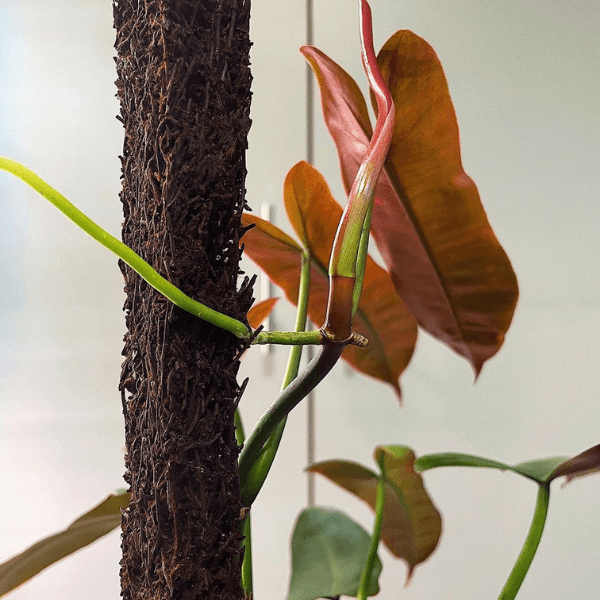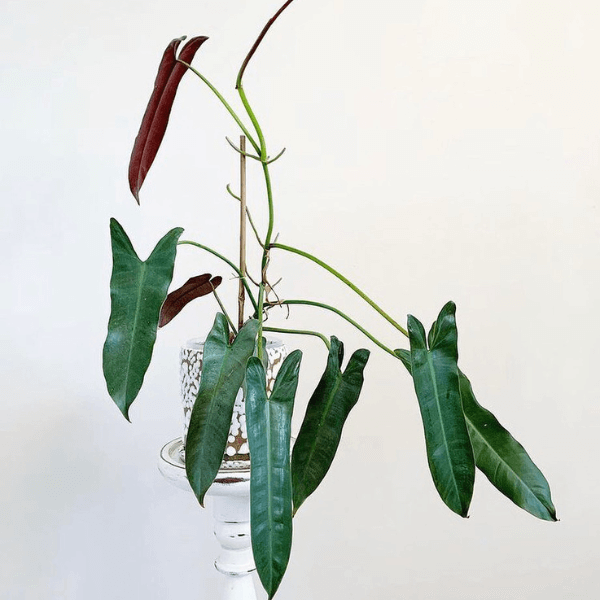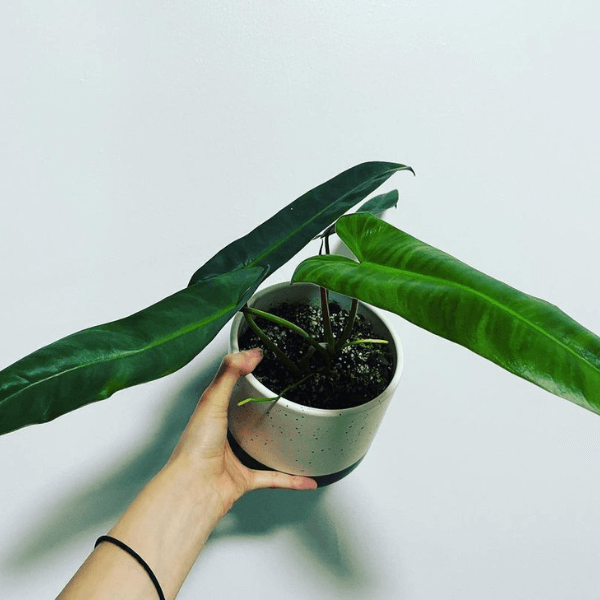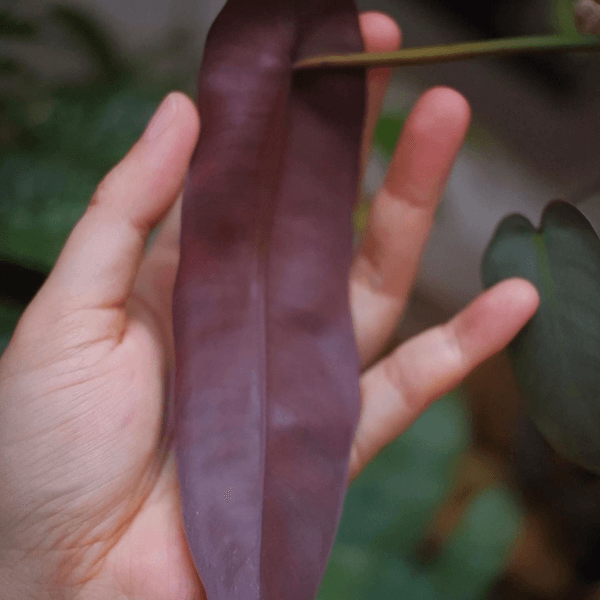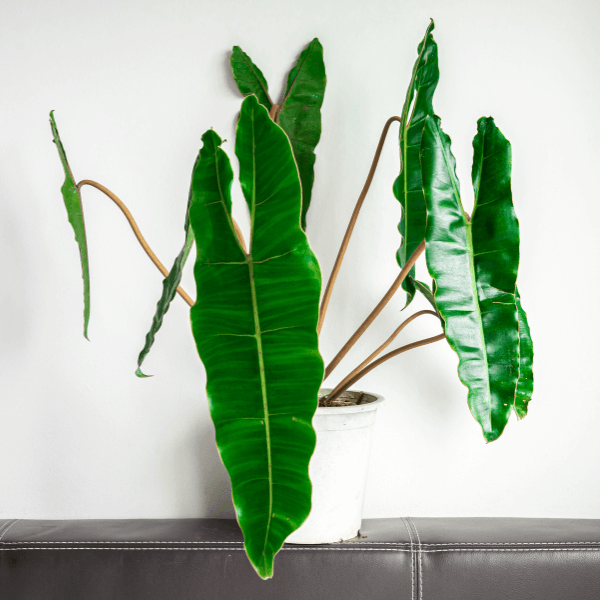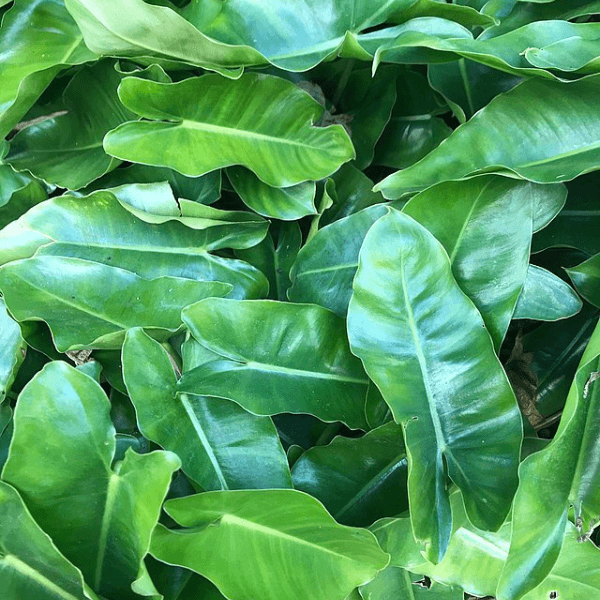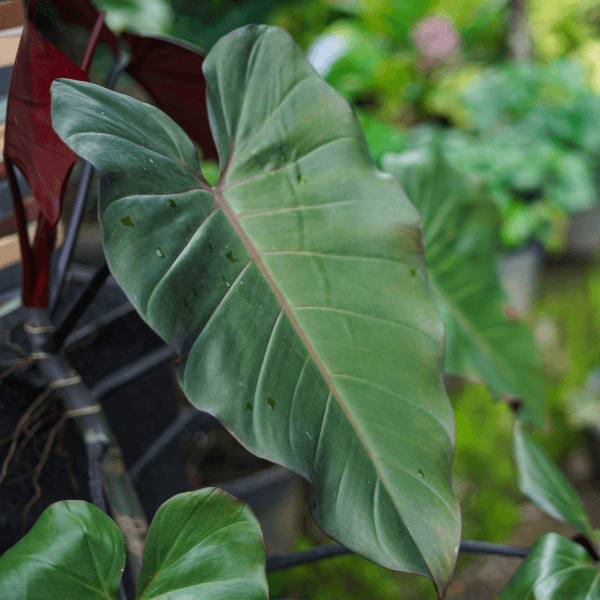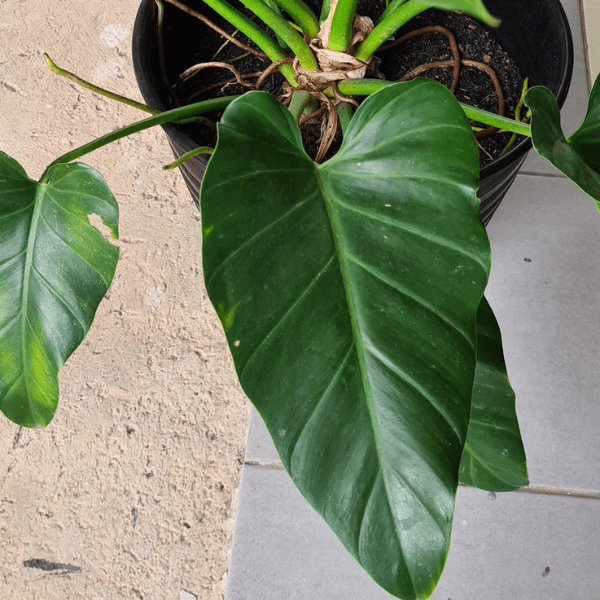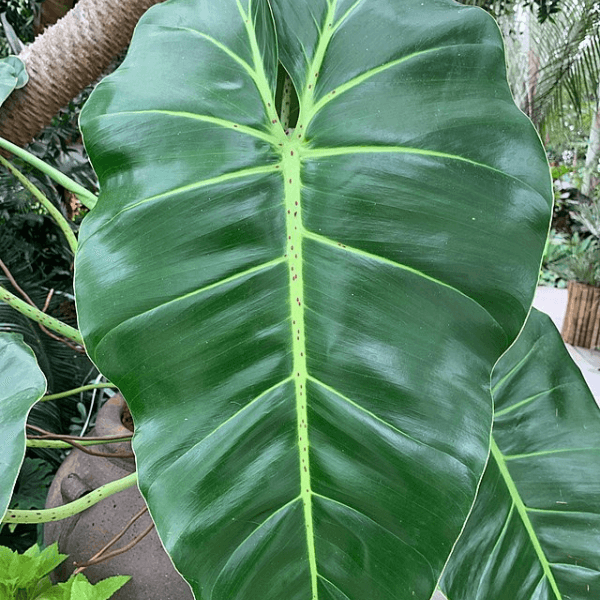The dual-colored foliage of Philodendron atabapoense makes this rare indoor climbing plant a popular choice. It has really beautiful foliage. At first glance, the leaves appear just green. When you turn the leaf upside down, you’ll notice a deep maroon red. There is a striking contrast between the dark green and the red leaves.
Each leaf is shaped like a small arrow, pointing in a different direction. The edges of mature leaves are sharper than those of juvenile leaves. There is no doubt that Philodendron atabapoense foliage is very effective.
Everyone can achieve great results with this easy-to-grow indoor jungle plant.
A rainforest plant collector’s dream or an excellent gift idea for jungle plant parents, Philodendron atabapoense is a beautiful and easy-to-grow tropical houseplant. Since they are air purifiers and tolerate neglect, they are an excellent choice for any indoor space.
Compared to other indoor plants, this one requires relatively little maintenance. One of the most challenging aspects of care is finding a good watering schedule and growing place with good light conditions. However, it isn’t nearly as hard as you think. Your philodendron will thrive under your care if you spend time getting to know it.
Philodendron atabapoense care
How much light does it need? 🌤️
Philodendron atabapoense needs bright indirect light to thrive. Avoid direct sunlight. A leaf that has been exposed to direct sunlight for an extended period of time can be burned. According to plant enthusiasts, a few hours of direct sunlight will not cause any damage. However, more than a few hours can cause serious trouble. Burnt leaves have a reddish-yellow color, which makes them easy to identify.
It will also tolerate less light. However, there will be fewer and smaller leaves on this plant, its growth will be leggy, and the gaps between its leaves will be wider. Changing your philodendron’s location to a brighter area will help it produce more giant leaves and bushier growth.
You can always use growing lights when you cannot provide philodendrons with brighter light. Grow lights should be kept 24″ (36cm) away from leaves to prevent leaf burn.
Is there a reason why philodendron leaves turn down?
In my experience, that means too much light. Leaves are shielding themselves from excessive sunlight. The leaves will probably straighten up again if the light levels are lowered (or taken out from under a grow light).
How often do I need to water? 💦
While watering this plant can be challenging, it’s not too difficult. First and foremost, do not overwater your philodendron atabapoense soil. Watering too much can cause problems.
Watering density depends on how quickly your plant soil dries out, so there is no exact formula for measuring it. There are several factors that affect this, including the room temperature, the type of pot, and others. A weekly soil moisture monitoring is recommended.
It is best to let half the soil dry out between waterings. So when 50% of the top layer of soil is dry, it’s time to water. You should remember that dry soil is better than wet soil when you are unsure whether you should water your plants.
It is easy to measure soil moisture with a soil moisture meter. If you don’t have soil meter, the topsoil can be felt by poking your finger into the pot. When the topsoil feels dry, water it. If not, wait a few more days and check again.
Lift the pot from time to time to check the soil moisture underneath. When you touch soil near drainage holes, you can evaluate its moisture. There are times when soil dries up quickly on top, but remains extremely wet underneath. You may not even notice root rot in this situation.
Watering needs can also be determined by lifting the pot and evaluating its weight. Wet soil weighs significantly more than dry soil. It takes time for a feeling of this kind to develop.
To minimize fuss, you can try bottom-watering. Using this technique, you will need a tray or container filled with water. Put the plant in water with its pot (which has drainage holes). Allow the plant to soak up water for 15-20 minutes. Your Philodendron will take as much water as it needs, so you don’t need to worry about how much water to give it.
Occasionally watering plants from the top is necessary if they are regularly watered from the bottom. Soil salts are removed in this way.
Common problems with watering philodendrons 🆘
Philodendron atabapoense can be sensitive to overwatering. There is a big risk of root rot when there is too much water. When you overwater your plant for a longer time; the roots might not be able to take any more water and will start to rot.
Consequently, leaves can also become slightly droopy since water isn’t transferred to them. Leaves will eventually turn yellow, brown, or crispy. Read more how to treat and avoid root rot.
If your philodendron atabapoense is thirsty for a long time, it will first look droopy, then drop its leaves. Leaves will turn yellow-brown before they fall.
Do I need to fertilize it? 💪
Philodendron atabapoense does not require much fertilizing. From time to time, you should give it a decent meal to keep up its healthy growth. It eventually uses all the nutrients in the soil, so you need to re-enrich the soil with new nutrients. Small leaves and slow growth might indicate that your plant lacks essential nutrients.
Fertilization of philodendrons is generally done with liquid fertilizer. For the best results, use specially formulated indoor fertilizers. As a rule of thumb, philodendrons are fertilized in the spring through fall when actively growing once a month. In winter, it is not necessary to fertilize but when the plant is thriving, just reduce it to every eight weeks.
Read the instructions on the fertilizer if you are debating how much to put. Fertilizers can differ slightly in composition and need to be handled differently.
What is the ideal temperature and humidity? 🌡
The optimal temperature range for philodendron atabapoense is 65-85°F (18-29°C) during the day and 60-70°F (16-21°C) at night.
During the warmer months, you may be able to take your philodendron outside. It will all depend on your local climate. Once warm weather is enough, you can take the plant outside and place it in the shade. Keep it out of direct sunlight. Philodendrons should be moved to a warm location before the temperature falls below 55°F (12°C) in the fall and winter.
You should keep your plant away from heat sources such as vents, hand dryers, furnaces, and other appliances since Philodendrons are sensitive to drastic temperature changes. Do not expose your plants to freezing temperatures, cold drafts, and frost during the winter.
Although it prefers humidity levels of 60-80%, it can also thrive in levels of 40-60%. When humidity drops below 40%, it’s essential to raise the humidity for plants to survive. Young plants are especially vulnerable to low humidity conditions.
The philodendron atabapoense requires high humidity between 65-70% to produce lush growth and richly colored leaves. You can place a humidifier near your plants if you are worried about humidity or if you see browning edges on your plant leaves. You will notice a big difference in your philodendrons health after this addition.
The Philodendron atabapoense can be grown outside throughout the USDA hardiness zone 11. The following map highlights the USDA hardiness zone 11 with light orange color:
Which soil is best for philodendron atabapoense? 🟤
Growing healthy plants requires slightly moist, well-draining soil that contains organic matter. You can use a special potting mix made for aroid family plants or just for green indoor plants which have some vermiculite or perlite inside them.
Alternatively, you can use orchid potting mix and add peat and perlite to improve aeration and lighten the soil. If you have a regular potting mix, you can add some big chunks, vermiculite, or perlite into it to make it airier and use it instead. It is also possible to mix vermiculite with peat, compost, and regular potting mix.
Plant roots struggle to survive in dense, heavy soil, and water isn’t absorbed either. It’s best to keep your soil at a pH of 5-8.
You can also grow this plant in 100% sphagnum moss. As the moss contains no nutrients, you will need to fertilize your plant periodically.
What pot should I choose? 🪴
The material or shape does not matter when it comes to pots. Just be sure your pot has holes for drainage. You’ll want the excess water from the soil near the roots to escape through the drainage holes in the pot.
Choosing a pot that blends into your interior and that you find beautiful is the best choice. My recommendation is to use a plastic planter pot inside ceramic, plastic, or other material beauty pots.
When should I repot? 😳
As soon as roots grow through drainage holes also signifies that it’s time to repot. It is generally recommended to replant every 2-3 years.
Avoid planting it in a container that is too big. There will be problems if philodendron has to deal with all the moisture and nutrients in that extra soil. Choose a pot that is 1-1,5 inches (2-4cm) larger than the old one.
Repotting Philodendron atabapoense is as easy as a breeze. You can watch the step-by-step guide here:
How well does it tolerate pruning? ✂️
Removing yellow, brown, and other unusually colored leaves is always a good idea. This is unnecessary, but it will make the plant look more beautiful and focus its energy on healthy leaves. You can first try gently pulling colored leaves off, but if that doesn’t work, just carefully cut the leaves.
Additionally, you can prune your philodendron atabapoense when it has grown too large and is taking up too much space. Cutting the stems at their base is the easiest way to do this. Make sure you water the plant afterward to minimize stress. It is good to know that stem cuttings can be used to propagate new plants.
Furthermore, light pruning will also promote new growth in the plant, whereas heavy pruning can shock the plant, resulting in slow growth.
PS! To avoid skin irritation from the plant’s sap, always wear gardening gloves. Also, I would recommend wearing gloves and sterilizing your pruning tools to prevent the spread of any fungus or disease.
Philodendron atabapoense propagation ☘️
Philodendron atabapeonse is an easy plant to propagate by stem cuttings. It’s a great chance to propagate new plants from cut stems if you need to prune a philodendron. Besides this, it’s normal to cut the stems for propagation purposes. You just need to ensure your mother plant has at least three remaining leaves.
If you want to root it in soil, follow the same steps to take cuttings and use vermiculite or regular potting soil as the rooting medium. Just make sure the potting mixture is kept moist. If you have a large mother plant, you can take more than one cutting and propagate all of them simultaneously.
Lastly, we recommend propagating in spring or early summer to give your plant ample time to reestablish before the non-growing month.
Watch a video tutorial how to propagate philodendron atabapoense:
Philodendron atabapoense growth & size 🧐
Philodendron atabapoense is a fast-growing plant; however, it highly depends on several factors. It can reach a height of 4-7 feet (1-2 meters), but on average, it will get 30 inches (80cm). It can reach its maximum height only with good vertical support as a climbing plant. You can use either a sphagnum moss pole or a bamboo stick to allow it to reach its full growth potential.
In addition, it needs good soil to develop strong roots and a well-established root system to reach higher. Light pruning will also encourage new growth in the plant, whereas heavy pruning can shock the plant resulting in slow growth.
Philodendron atabapoense flowers 🌸
Philodendron atabapoense rarely shows its blooms indoors. When it does, the spathe for the atabapoense is purplish-brown on the inside and green on the outside. Their peduncle is green with purplish spots towards the apex, and the spathe is green outside with a pink-wine margin and purplish-brown inside but whitish on the blade. However, the blooms are the most insignificant part of this plant.
It is possible to see some blossoms if you grow your plant in the most acceptable conditions and make it as happy as possible. However, you must know that most philodendrona atabapoense plants generally bloom in an outdoor environment.
Philodendron atabapoense toxicity
Philodendron atabapoense is toxic to pets & humans. It has a moderate level of toxicity, and chewing its leaves or stems can cause mild symptoms.
Insoluble calcium oxalate crystals cause the symptoms in philodendrons’ stems and leaves. Crystals are released upon chewing or biting into this plant, causing tissue penetration and irritation in the mouth and GI tract. It is rare to experience swelling of the upper airways, making breathing difficult.
According to the Pet Poison Helpline, these are some signs to watch for:
- Drooling
- Pawing at the mouth
- Oral pain
- Decreased appetite
- Vomiting
Keep philodendrons up and away from cats, dogs, and children since they are not pet- or kid-friendly.
To sum it up, philodendron atabapoense is a beautiful indoor plant that requires little maintenance. Once you know it, it will be easy peasy—an excellent addition to any jungle plant collection or a wonderful plant parent gift.
If you did not get the answer you were looking for, feel free to ask any additional questions you have in the comment section below. In any case, I will be happy to assist you.
Already a happy Philodendron atabapoense parent? I’d love to see a picture of your plant! It would be great if you could share any advice or tips you’ve gained from your experience with this plant.
Let us know in the comments & let’s make this article even more helpful to readers like you.


